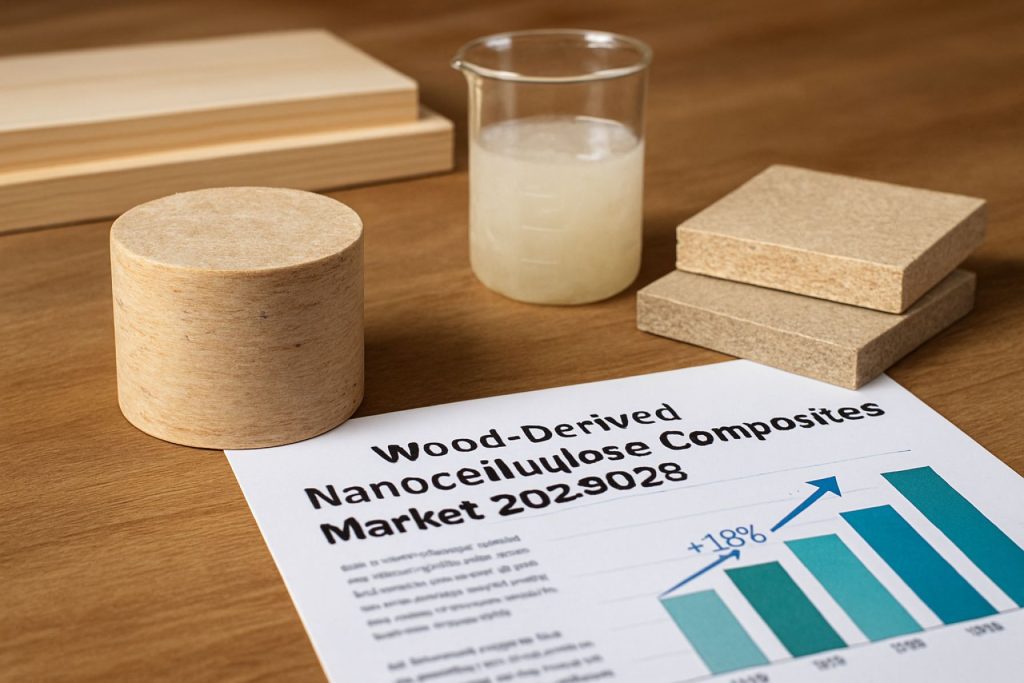
2025 Wood-Derived Nanocellulose Composites Manufacturing Report: Market Dynamics, Technology Breakthroughs, and Global Growth Outlook. Explore Key Trends, Competitive Analysis, and Strategic Opportunities Shaping the Next 5 Years.
- Executive Summary & Market Overview
- Key Technology Trends in Nanocellulose Composites
- Competitive Landscape and Leading Manufacturers
- Market Size, Growth Forecasts & CAGR Analysis (2025–2030)
- Regional Market Analysis: North America, Europe, Asia-Pacific & Rest of World
- Emerging Applications and End-User Insights
- Challenges, Risks, and Barriers to Adoption
- Opportunities and Strategic Recommendations
- Future Outlook: Innovation Pathways and Market Evolution
- Sources & References
Executive Summary & Market Overview
Wood-derived nanocellulose composites represent a rapidly advancing segment within the sustainable materials market, leveraging the unique mechanical, thermal, and barrier properties of nanocellulose extracted from wood fibers. Nanocellulose, which includes cellulose nanofibrils (CNF) and cellulose nanocrystals (CNC), is produced through mechanical, chemical, or enzymatic processes that break down wood pulp into nanoscale fibers. These nanomaterials are then incorporated into polymer matrices to create composites with enhanced strength-to-weight ratios, biodegradability, and tunable functionalities.
The global market for wood-derived nanocellulose composites is projected to experience robust growth through 2025, driven by increasing demand for sustainable alternatives to petroleum-based plastics in packaging, automotive, construction, and electronics. According to MarketsandMarkets, the nanocellulose market is expected to reach USD 783 million by 2025, with composites accounting for a significant share of this expansion. The Asia-Pacific region, particularly Japan, China, and Finland, is at the forefront of commercial-scale manufacturing, supported by strong R&D investments and government initiatives promoting bio-based materials.
Key industry players such as Stora Enso, UPM-Kymmene Corporation, and Sappi Limited have established pilot and commercial production facilities, focusing on scalable, cost-effective manufacturing processes. These companies are collaborating with downstream partners to develop application-specific nanocellulose composites, targeting lightweight automotive components, high-barrier packaging films, and advanced filtration media.
Despite the promising outlook, the sector faces challenges related to high production costs, scalability, and the need for standardized quality metrics. Ongoing research aims to optimize extraction and compounding techniques, reduce energy consumption, and improve the compatibility of nanocellulose with various polymer matrices. Regulatory support and the growing emphasis on circular economy principles are expected to further accelerate market adoption.
In summary, wood-derived nanocellulose composites manufacturing is poised for significant growth in 2025, underpinned by technological advancements, expanding end-use applications, and a global shift toward sustainable materials. Strategic investments and cross-industry collaborations will be critical in overcoming current barriers and unlocking the full commercial potential of these innovative composites.
Key Technology Trends in Nanocellulose Composites
Wood-derived nanocellulose composites manufacturing is experiencing rapid technological evolution, driven by the demand for sustainable, high-performance materials across industries such as packaging, automotive, and construction. In 2025, several key technology trends are shaping the production landscape of these composites, focusing on scalability, cost reduction, and enhanced material properties.
One of the most significant advancements is the optimization of mechanical and chemical pretreatment processes for wood pulp. Enzymatic hydrolysis and TEMPO-mediated oxidation are increasingly adopted to produce cellulose nanofibrils (CNF) and cellulose nanocrystals (CNC) with controlled morphology and surface chemistry. These methods improve yield and reduce energy consumption, addressing a major bottleneck in large-scale production. Companies like Stora Enso and UPM are investing in pilot plants that leverage these advanced processes to achieve commercial viability.
Another trend is the integration of continuous processing technologies, such as high-shear homogenization and microfluidization, which enable the consistent production of nanocellulose at industrial scales. These methods are being refined to minimize fiber aggregation and ensure uniform dispersion within polymer matrices, a critical factor for achieving superior composite performance. Research initiatives, such as those supported by Fraunhofer Society, are focusing on process automation and real-time quality monitoring to further enhance throughput and reproducibility.
Surface modification techniques are also advancing, with a focus on tailoring nanocellulose interfaces for compatibility with hydrophobic polymers. Grafting, silanization, and acetylation are being employed to improve dispersion and interfacial bonding, resulting in composites with enhanced mechanical strength, barrier properties, and thermal stability. These innovations are particularly relevant for applications in flexible packaging and lightweight automotive components, as highlighted in recent market analyses by MarketsandMarkets.
Finally, sustainability remains a core driver, with manufacturers increasingly adopting closed-loop water systems and green chemistry approaches to minimize environmental impact. The use of wood waste and byproducts as feedstock is gaining traction, aligning with circular economy principles and regulatory pressures for eco-friendly materials. As these technology trends converge, wood-derived nanocellulose composites are poised for broader adoption and market growth in 2025 and beyond.
Competitive Landscape and Leading Manufacturers
The competitive landscape for wood-derived nanocellulose composites manufacturing in 2025 is characterized by a dynamic mix of established pulp and paper companies, specialized nanomaterials firms, and emerging startups. The sector is witnessing increased investments, strategic partnerships, and technology licensing agreements as companies seek to capitalize on the growing demand for sustainable, high-performance materials in packaging, automotive, construction, and electronics.
Leading manufacturers include Stora Enso, which has scaled up its nanocellulose production capacity in Europe and is actively collaborating with packaging and bioplastics companies. UPM-Kymmene Corporation is another major player, leveraging its extensive forestry resources and R&D capabilities to develop nanocellulose-based composites for industrial applications. Sappi Limited has commercialized its branded nanocellulose product, Valida, targeting both rheology modification and composite reinforcement markets.
In North America, CelluForce and American Process Inc. are prominent, with CelluForce operating one of the world’s largest nanocrystalline cellulose (NCC) plants and focusing on automotive and oil & gas sectors. American Process Inc. has developed proprietary technologies for low-cost nanocellulose extraction and is engaged in joint ventures to expand its market reach.
Asian manufacturers are rapidly scaling up, with Daicel Corporation and Nippon Paper Industries investing in pilot plants and forming alliances with electronics and packaging companies. These firms benefit from strong government support for bio-based materials and proximity to high-growth end-user markets.
- Strategic collaborations are common, such as Stora Enso’s partnership with Tetra Pak to develop fiber-based barrier materials.
- Startups like Blue Ocean Solutions and Charm Industrial are innovating in nanocellulose functionalization and upcycling wood waste.
- Patent activity is intensifying, with a focus on scalable production methods and composite performance enhancements.
Overall, the competitive landscape in 2025 is marked by rapid technological advancements, increasing production capacities, and a shift toward integrated value chains, as manufacturers position themselves to meet the surging demand for sustainable nanocellulose composites.
Market Size, Growth Forecasts & CAGR Analysis (2025–2030)
The global market for wood-derived nanocellulose composites manufacturing is poised for robust expansion between 2025 and 2030, driven by increasing demand for sustainable, high-performance materials across multiple industries. In 2025, the market size is estimated to reach approximately USD 1.2 billion, with projections indicating a compound annual growth rate (CAGR) of 21–24% through 2030. This rapid growth is underpinned by the material’s unique properties—such as high strength-to-weight ratio, biodegradability, and versatility—which are attracting significant interest from sectors including packaging, automotive, construction, and electronics.
According to MarketsandMarkets, the nanocellulose market as a whole is expected to surpass USD 2.5 billion by 2030, with wood-derived composites accounting for a substantial share due to their scalability and compatibility with existing manufacturing processes. The Asia-Pacific region is anticipated to lead market growth, fueled by strong investments in green technologies and the presence of major pulp and paper industries in countries such as Japan, China, and Finland. North America and Europe are also expected to witness significant adoption, particularly in advanced packaging and automotive applications, where regulatory pressures and consumer preferences are accelerating the shift toward bio-based materials.
- Packaging: The packaging segment is projected to be the largest end-use market, with a CAGR exceeding 22% from 2025 to 2030, as companies seek alternatives to petroleum-based plastics and focus on circular economy initiatives.
- Automotive & Transportation: Adoption in automotive composites is forecast to grow at a CAGR of 20–23%, driven by the need for lightweight, durable, and eco-friendly materials to meet stringent emission standards.
- Construction: The construction sector is expected to see increased use of nanocellulose-reinforced composites in insulation, panels, and coatings, contributing to a CAGR of 19–21% in this segment.
Key market drivers include ongoing R&D investments, government incentives for sustainable materials, and the scaling up of pilot projects to commercial production. However, challenges such as high production costs and the need for standardized quality control may temper growth in the short term. Overall, the outlook for wood-derived nanocellulose composites manufacturing remains highly positive, with significant opportunities for innovation and market penetration through 2030 (Grand View Research).
Regional Market Analysis: North America, Europe, Asia-Pacific & Rest of World
The global market for wood-derived nanocellulose composites is experiencing dynamic regional growth, with North America, Europe, Asia-Pacific, and the Rest of the World (RoW) each exhibiting distinct trends and drivers in 2025.
North America remains a leader in nanocellulose composites manufacturing, propelled by robust R&D investments, a strong focus on sustainable materials, and the presence of key industry players. The United States and Canada are at the forefront, leveraging advanced manufacturing infrastructure and government support for green technologies. The region’s demand is particularly strong in packaging, automotive, and construction sectors, where lightweight and biodegradable materials are prioritized. According to Forest Products Society, North American manufacturers are increasingly integrating nanocellulose into bioplastics and coatings, with several pilot plants scaling up to commercial production in 2025.
Europe is characterized by stringent environmental regulations and ambitious circular economy goals, which are accelerating the adoption of wood-derived nanocellulose composites. Countries such as Sweden, Finland, and Germany are leading innovation, supported by EU-funded research initiatives and collaborations between academia and industry. The European market is witnessing rapid commercialization in packaging, electronics, and medical applications. As reported by Confederation of European Paper Industries (CEPI), the region’s pulp and paper sector is investing heavily in nanocellulose production facilities, aiming to reduce carbon footprints and enhance product performance.
- Asia-Pacific is emerging as the fastest-growing market, driven by expanding industrialization, abundant forestry resources, and increasing demand for sustainable materials in China, Japan, and South Korea. The region benefits from cost-effective raw material supply chains and government incentives for green manufacturing. According to Frost & Sullivan, Asia-Pacific’s nanocellulose composites output is expected to surpass other regions by 2025, with significant uptake in electronics, automotive, and consumer goods.
- Rest of the World (RoW) includes Latin America, the Middle East, and Africa, where market penetration is still nascent but growing. Brazil is a notable player, leveraging its vast forestry sector to explore nanocellulose applications, particularly in packaging and agriculture. The RoW market is expected to benefit from technology transfer and international partnerships, as highlighted by Food and Agriculture Organization of the United Nations (FAO).
Overall, regional dynamics in 2025 reflect a convergence of sustainability goals, technological advancements, and policy support, positioning wood-derived nanocellulose composites as a key material in the global shift toward bio-based industries.
Emerging Applications and End-User Insights
The manufacturing of wood-derived nanocellulose composites is rapidly evolving, with emerging applications and end-user insights shaping the market landscape in 2025. Nanocellulose, extracted from wood pulp, offers exceptional mechanical strength, lightweight properties, and biodegradability, making it a sought-after material for advanced composites. Recent advancements in processing technologies—such as high-shear homogenization, enzymatic pretreatment, and solvent exchange—have enabled scalable production of nanocellulose composites with tailored functionalities for diverse industries.
Key emerging applications are concentrated in sectors prioritizing sustainability and performance. The packaging industry is increasingly adopting nanocellulose composites as barrier films and coatings, replacing petroleum-based plastics due to their superior oxygen and moisture resistance. Major packaging manufacturers are piloting multilayer films incorporating nanocellulose to enhance shelf life and recyclability, responding to consumer and regulatory pressures for eco-friendly solutions (Tetra Pak).
In the automotive and aerospace sectors, nanocellulose-reinforced polymers are being integrated into interior panels, structural components, and lightweight composites. These applications leverage nanocellulose’s high strength-to-weight ratio and its ability to improve the mechanical properties of bioplastics, contributing to vehicle weight reduction and improved fuel efficiency (Airbus). The construction industry is also exploring nanocellulose composites for high-performance, sustainable building materials, such as insulation panels and cement additives, to enhance durability and reduce carbon footprints (Holcim).
End-user insights reveal a growing demand for customization and functionalization. Manufacturers are seeking nanocellulose composites with specific barrier, mechanical, or optical properties tailored to their product requirements. Collaborative R&D initiatives between nanocellulose producers and end-users are accelerating the development of application-specific grades, particularly in electronics (flexible displays, conductive films) and healthcare (biocompatible scaffolds, wound dressings) (Stora Enso).
Despite these opportunities, end-users cite challenges such as cost competitiveness, supply chain scalability, and the need for standardized quality metrics. Industry stakeholders are addressing these barriers through investments in pilot-scale facilities, strategic partnerships, and the development of international standards for nanocellulose materials (Cellulose from Finland). As a result, the adoption of wood-derived nanocellulose composites is expected to accelerate across multiple sectors in 2025, driven by sustainability imperatives and the pursuit of advanced material performance.
Challenges, Risks, and Barriers to Adoption
The manufacturing of wood-derived nanocellulose composites faces several significant challenges, risks, and barriers to widespread adoption as of 2025. Despite the material’s promise for lightweight, high-strength, and sustainable applications, the path to commercialization is hindered by technical, economic, and regulatory factors.
- Technical Complexity and Scale-Up: The transition from laboratory-scale production to industrial-scale manufacturing remains a major hurdle. Achieving consistent quality, uniform dispersion of nanocellulose within composite matrices, and reproducibility at scale are persistent issues. The sensitivity of nanocellulose to moisture and its tendency to agglomerate complicate processing, often requiring specialized equipment and surface modification techniques, which can increase costs and complexity (Cellulose Chemistry and Technology).
- High Production Costs: The extraction and purification of nanocellulose from wood are energy-intensive and involve multiple chemical and mechanical steps. The cost of raw materials, processing, and post-treatment currently makes nanocellulose composites less competitive compared to conventional materials such as glass or carbon fiber composites. According to Frost & Sullivan, the price disparity is a key barrier for industries seeking cost-effective alternatives.
- Supply Chain and Feedstock Variability: The quality and properties of nanocellulose are highly dependent on the source wood species and extraction methods. Variability in feedstock can lead to inconsistent product performance, posing challenges for manufacturers aiming for standardized, high-performance composites (Polymer Testing).
- Regulatory and Safety Concerns: The introduction of nanomaterials into consumer products raises regulatory scrutiny regarding health and environmental impacts. There is a lack of harmonized standards for nanocellulose characterization, safety assessment, and labeling, which can delay product approvals and market entry (OECD).
- Market Awareness and Acceptance: End-users and manufacturers may be hesitant to adopt nanocellulose composites due to limited familiarity with the material’s properties, processing requirements, and long-term performance. This knowledge gap slows down the integration of nanocellulose into established value chains (MarketsandMarkets).
Addressing these challenges will require coordinated efforts in research, standardization, and investment to unlock the full potential of wood-derived nanocellulose composites in the coming years.
Opportunities and Strategic Recommendations
The wood-derived nanocellulose composites manufacturing sector is poised for significant growth in 2025, driven by increasing demand for sustainable materials, regulatory support for bio-based products, and advancements in processing technologies. Several key opportunities and strategic recommendations can be identified for stakeholders aiming to capitalize on this evolving market.
- Expansion into High-Value Applications: Nanocellulose composites are gaining traction in automotive, packaging, electronics, and biomedical sectors due to their lightweight, high strength, and biodegradability. Companies should prioritize R&D partnerships with end-users in these industries to co-develop tailored solutions, as demonstrated by collaborations between Stora Enso and packaging manufacturers.
- Process Optimization and Cost Reduction: Manufacturing costs remain a barrier to large-scale adoption. Strategic investments in process innovation—such as enzymatic pretreatment, energy-efficient mechanical fibrillation, and continuous production lines—can significantly lower costs. Firms like American Process Inc. have showcased pilot-scale advancements that improve yield and reduce energy consumption.
- Geographic Expansion and Localization: Asia-Pacific, particularly China and Japan, is emerging as a major market due to robust government support and a strong manufacturing base. Establishing local production facilities or joint ventures in these regions can help companies tap into growing demand and benefit from favorable regulatory environments, as highlighted in MarketsandMarkets research.
- Strategic Alliances and Licensing: Forming alliances with pulp and paper companies, chemical suppliers, and research institutions can accelerate technology transfer and market entry. Licensing proprietary nanocellulose processing technologies to established players can also generate new revenue streams.
- Regulatory and Certification Leverage: Proactively engaging with regulatory bodies to shape standards for nanocellulose composites and obtaining eco-certifications (such as FSC or Cradle to Cradle) can enhance market acceptance and open doors to premium segments, especially in Europe and North America.
In summary, the 2025 landscape for wood-derived nanocellulose composites manufacturing offers robust opportunities for growth through innovation, strategic partnerships, and market diversification. Companies that invest in process efficiency, application development, and global expansion are well-positioned to capture a significant share of this rapidly evolving market.
Future Outlook: Innovation Pathways and Market Evolution
The future outlook for wood-derived nanocellulose composites manufacturing in 2025 is shaped by accelerating innovation, expanding application domains, and evolving market dynamics. As sustainability imperatives intensify across industries, nanocellulose—extracted from wood pulp—has emerged as a critical enabler for next-generation, eco-friendly composite materials. The manufacturing landscape is expected to witness significant advancements in both process efficiency and scalability, driven by ongoing R&D investments and strategic collaborations between academia and industry.
Key innovation pathways include the development of energy-efficient extraction and functionalization techniques, such as enzymatic pretreatment and green chemistry approaches, which reduce environmental impact and production costs. Companies are also focusing on integrating nanocellulose with biopolymers and recycled plastics to create high-performance composites for automotive, packaging, and construction sectors. For instance, pilot projects in Europe and North America are demonstrating the feasibility of continuous, large-scale nanocellulose composite production lines, leveraging advances in dispersion technology and surface modification to enhance compatibility with diverse polymer matrices (Stora Enso).
Market evolution is characterized by a shift from niche, high-value applications—such as specialty coatings and medical devices—toward broader adoption in mainstream manufacturing. This transition is supported by improving cost competitiveness and the establishment of supply chains for nanocellulose feedstock. According to recent forecasts, the global nanocellulose market is projected to grow at a CAGR exceeding 20% through 2025, with wood-derived nanocellulose composites accounting for a substantial share of this expansion (MarketsandMarkets).
- Automotive: Lightweight, strong nanocellulose composites are being trialed for interior and structural components, aiming to reduce vehicle weight and improve fuel efficiency.
- Packaging: Biodegradable nanocellulose-based films and containers are gaining traction as alternatives to conventional plastics, aligning with regulatory and consumer sustainability demands.
- Electronics: Flexible, transparent nanocellulose substrates are under development for use in displays and sensors, leveraging their unique mechanical and optical properties (Arkema).
In summary, 2025 is poised to be a pivotal year for wood-derived nanocellulose composites manufacturing, marked by technological breakthroughs, expanding end-use markets, and a maturing ecosystem that supports commercial-scale adoption.
Sources & References
- MarketsandMarkets
- UPM-Kymmene Corporation
- Fraunhofer Society
- CelluForce
- American Process Inc.
- Daicel Corporation
- Nippon Paper Industries
- Grand View Research
- Confederation of European Paper Industries (CEPI)
- Frost & Sullivan
- Food and Agriculture Organization of the United Nations (FAO)
- Airbus
- Holcim
- Cellulose Chemistry and Technology
- Arkema



